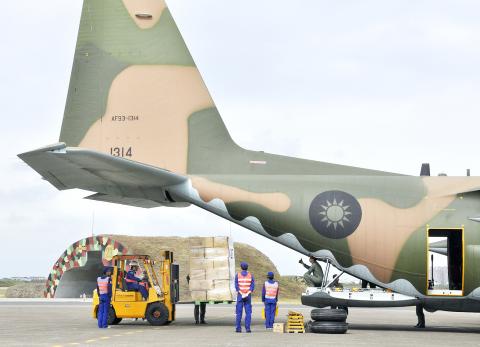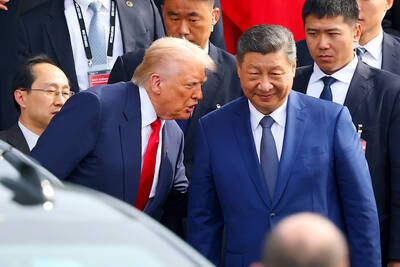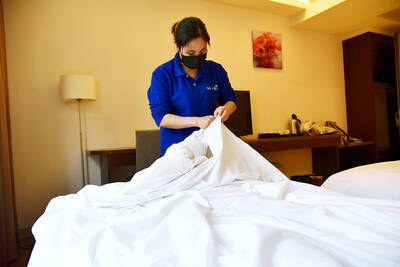Two Republic of China (ROC) Air Force C-130 transport aircraft laden with relief supplies flew to the Philippines yesterday.
One plane left at 1:15pm from Hsinchu Air Force Base, and the second left eight minutes later, each carrying 7.5 tonnes of relief goods, including instant noodles, dry food, military blankets and other items.
The air force said the two planes would fly directly to Cebu City in the central Philippines, a journey of about three hours, and would return immediately after unloading.

Photo: Reuters
The Ministry of Foreign Affairs said about 100 tonnes of goods had been collected so far for survivors of Typhoon Haiyan and that more missions were expected.
Ministry of National Defenese spokesman Major General David Lo (羅紹和) told a press conference that 20 crew members and one Ministry of Foreign Affairs official were taking part in the mission.
He said whether more flights would be scheduled depended on weather conditions and the amount of relief supplies collected.
The relief aid was donated mainly by Buddhist organizations, including the Buddhist Compassion Relief Tzu Chi Foundation, Fo Guang Shan, Ling Jiou Mountain and Dharma Drum Mountain, as well as the Red Cross Society of the ROC.
The air force said the C-130s have taken part in other international relief missions, including the South Asia tsunami in 2010 and Haitian earthquake in 2004.
Taiwan’s representative office in the Philippines said the government had originally wanted to send the supplies directly to the typhoon-ravaged city of Tacloban, but it accepted the suggestion of Manila officials to send the planes to Cebu City.
The Philippine government has said the airport in Tacloban was seriously damaged in the typhoon, and looting in the area and a curfew imposed on the city has made it a less than ideal place to send supplies.
The foreign ministry said on Sunday that Taiwan has extended its sympathy to the Philippines over the devastation caused by Haiyan and had donated US$200,000 toward relief efforts.
However, local media have reported that some people have been opposed to providing relief aid because of the May 9 shooting incident that killed Taiwanese fisherman Hung Shih-cheng (洪石成). The incident triggered a diplomatic standoff that lasted until early August.
In response to media queries yesterday, Hung’s daughter Hung Tzu-chien (洪慈綪) said: “The government [of the Philippines] might have no humanity, but the people are innocent.”
“Based on humanity, I definitely support the relief missions,” she said.
She said the shooting of her father was an inhumane act by Philippines Coast Guard personnel, but it had nothing to do with helping survivors of such a disaster.
Meanwhile, the Tzu Chi Foundation said it has set up a disaster response center to deliver supplies and provide relief to the areas devastated by Haiyan.
The Hualien-based foundation said it had collected 30,000 blankets and 200,000 packets of instant rice meals so far, and that all of the blankets and 60,000 packets of instant rice packets had been sent on the two air force planes that left yesterday.
More relief supplies are being sent to Taipei by train and truck for shipment to the Philippines.
A medical and disaster relief team consisting of 40 Tzu Chi volunteer workers in the Philippines, including 10 medical experts, will head to the typhoon-stricken areas today to directly assist victims, a foundation spokesman said.
Haiyan, which struck on Friday last week, was one of the most powerful storms to ever hit land and death toll estimates have ranged up to 10,000 people, though the lack of contact with many of the devastated areas has made it difficult for Philippine authorities to get an accurate count of the casualities and the damage.
Additional reporting by CNA

CALL FOR SUPPORT: President William Lai called on lawmakers across party lines to ensure the livelihood of Taiwanese and that national security is protected President William Lai (賴清德) yesterday called for bipartisan support for Taiwan’s investment in self-defense capabilities at the christening and launch of two coast guard vessels at CSBC Corp, Taiwan’s (台灣國際造船) shipyard in Kaohsiung. The Taipei (台北) is the fourth and final ship of the Chiayi-class offshore patrol vessels, and the Siraya (西拉雅) is the Coast Guard Administration’s (CGA) first-ever ocean patrol vessel, the government said. The Taipei is the fourth and final ship of the Chiayi-class offshore patrol vessels with a displacement of about 4,000 tonnes, Lai said. This ship class was ordered as a result of former president Tsai Ing-wen’s (蔡英文) 2018

UKRAINE, NVIDIA: The US leader said the subject of Russia’s war had come up ‘very strongly,’ while Jenson Huang was hoping that the conversation was good Chinese President Xi Jinping (習近平) and US President Donald Trump had differing takes following their meeting in Busan, South Korea, yesterday. Xi said that the two sides should complete follow-up work as soon as possible to deliver tangible results that would provide “peace of mind” to China, the US and the rest of the world, while Trump hailed the “great success” of the talks. The two discussed trade, including a deal to reduce tariffs slapped on China for its role in the fentanyl trade, as well as cooperation in ending the war in Ukraine, among other issues, but they did not mention

HOTEL HIRING: An official said that hoteliers could begin hiring migrant workers next year, but must adhere to a rule requiring a NT$2,000 salary hike for Taiwanese The government is to allow the hospitality industry to recruit mid-level migrant workers for housekeeping and three other lines of work after the Executive Yuan yesterday approved a proposal by the Ministry of Labor. A shortage of workers at hotels and accommodation facilities was discussed at a meeting of the legislature’s Transportation Committee. A 2023 survey conducted by the Tourism Administration found that Taiwan’s lodging industry was short of about 6,600 housekeeping and cleaning workers, the agency said in a report to the committee. The shortage of workers in the industry is being studied, the report said. Hotel and Lodging Division Deputy Director Cheng

‘SECRETS’: While saying China would not attack during his presidency, Donald Trump declined to say how Washington would respond if Beijing were to take military action US President Donald Trump said that China would not take military action against Taiwan while he is president, as the Chinese leaders “know the consequences.” Trump made the statement during an interview on CBS’ 60 Minutes program that aired on Sunday, a few days after his meeting with Chinese President Xi Jinping (習近平) in South Korea. “He [Xi] has openly said, and his people have openly said at meetings, ‘we would never do anything while President Trump is president,’ because they know the consequences,” Trump said in the interview. However, he repeatedly declined to say exactly how Washington would respond in